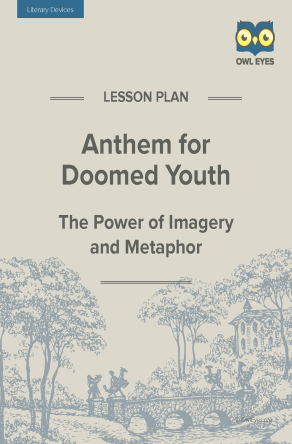Anthem for Doomed Youth Literary Devices Lesson Plan
- 18 pages
- Subject: Imagery, Literary Devices, Metaphor, Themes, Lesson Plans and Educational Resources
- Common Core Standards: RL.9-10.1, RL.9-10.2, RL.9-10.4, SL.9-10.1
- Grade Levels: 9, 10, 11, 12
Additional Anthem for Doomed Youth Resources
Product Description
Literary Devices: The Power of Imagery and Metaphor in “Anthem for Doomed Youth”
This lesson plan focuses on Wilfred Owen's use of imagery and metaphor in “Anthem for Doomed Youth.” Students will review the definitions of imagery and metaphor and examine how Owen’s metaphors are created through imagery. By the end of this lesson, students will be able to analyze contrasting elements in the text and explain how they contribute to themes in the poem. In studying imagery and metaphor in the poem, students will gain an understanding of how Owen powerfully conveys the emotions and experiences of WWI soldiers while expressing outrage over the seeming futility of their deaths.
Skills: close reading; contrasting elements in the text; interpreting connotative meaning and figurative language; drawing inferences from the text
Learning Objectives: By the end of the lesson, students will be able to
- define and explain metaphor and imagery as poetry devices
- identify metaphors and images in the poem and interpret their meaning
- analyze and explain how metaphors in the poem are created through imagery
- analyze how the traumatic experience of WWI soldiers is expressed through imagery
About This Document
Owl Eyes lesson plans have been developed to meet the demanding needs of today’s educational environment and bridge the gap between online learning and in-class instruction. The main components of each plan include the following:
- An introduction to the text
- A step-by-step guide to lesson procedure
- Previous and following lesson synopses for preparation and extension ideas
- A collection of handouts and worksheets complete with answer keys
Each of these comprehensive, 60-minute plans focus on promoting meaningful interaction, analytical skills, and student-centered activities, drawing from the Common Core Standards for English Language Arts and the expertise of classroom teachers.
Introduction to the Lesson
The front lines of World War I inspired some first-rate English poetry while decimating a generation of young fighting men on a scale that few anticipated.
Wilfred Owen may be the most accomplished and best known of the war’s soldier-poets. His poem “Anthem for Doomed Youth” delivers his characteristically visceral depictions of the violence endured by soldiers fighting in the trenches. It achieves its power with a series of contrasting images: chaotic battle scenes are set beside the solemn rituals of English funerary tradition, highlighting the way modern warfare stripped all dignity, comfort, and meaning from the deaths of the young soldiers. Close readings of his work reveal that underlying his war poems is a deep anger over the futility of the conflict and the emptiness of the soldiers’ sacrifices.
Owen’s depiction of warfare has little in common with the orderly scenes of glorious cavalry charges romanticized by English poets of the past. Like most young Englishmen who rushed to enlist when war broke in 1914, Owen expected a short conflict that would not only end with a decisive victory but also provide ample opportunities for noble action along the way. His hopes, and the hopes of many others, were shattered as he witnessed the bloodshed and seemingly endless stalemate ushered in by military innovations such as machine guns, nerve gas, and barbed wire. Sadly, Owen’s death on the battlefield in November of 1918, just a week before the end of the war, meant he did not live to see most of his poems published. His poetic output was not lost or forgotten, though, thanks to his friend and literary mentor, Siegfried Sassoon, who survived the war and guided his deceased friend’s poems though publication.
Worksheet Excerpt
Identifying and Analyzing Examples of Imagery
- Identify several examples of imagery in the stanza your group has been assigned.
- Highlight each example and analyze it. Write an annotation for each example that explains your analysis.
- In each annotation, include the following information:
- Which type of image is it? (Which sense or senses does it appeal to?)
- What is being described?
- What does the image suggest to readers?
- Discuss the stanza together in identifying and analyzing examples of imagery, and choose one person in your group to write the annotations to the stanza.







